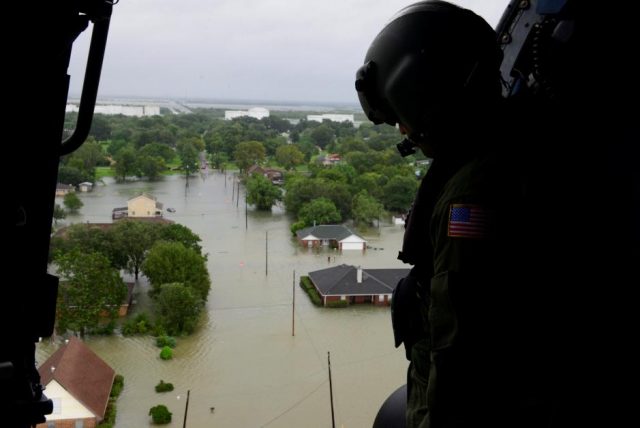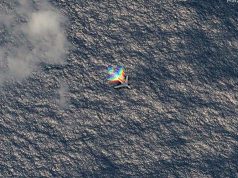
LAKE CHARLES, La./HOUSTON — Tropical Storm Harvey spun across southeastern Texas into Louisiana on Wednesday, sending more people fleeing for shelter after swamping Houston with record rains and flooding that killed at least 25 and drove tens of thousands from their homes.
The slow-moving storm has forced 32,000 people to seek shelter since coming ashore on Friday near Corpus Christi, Texas, as the most powerful hurricane to hit Texas in more than half a century. On Wednesday, it pummeled a stretch of coast from Port Arthur, Texas, to Lake Charles, Louisiana.
Among the latest deaths reported were two people who drowned while driving through high water near Simonton, Texas, 40 miles (64 km) west of Houston, Major Chad Norvell of the Fort Bend County Sheriff’s Office said on Twitter.
Houston’s KHOU-TV reported that an infant girl was swept away by floodwaters as her parents were driving from Houston toward Louisiana on Highway 150. Police in Harris County, home to Houston, said 17 people remained missing.
Busloads of people fleeing floodwaters around Port Arthur arrived in Lake Charles, joining local residents who had already packed into shelters to escape waterlogged homes.
Harvey was forecast to drop a further 3 to 6 inches (7.5-15 cm) of rain on Wednesday, with a storm surge of up to 4 feet (1.2 meters) along the western part of Louisiana’s Gulf Coast. The floods shut the nation’s largest oil refinery in Port Arthur in the latest hit to U.S. energy infrastructure that has sent gasoline prices climbing and disrupted global fuel supplies.
‘Worst not yet over’
Moody’s Analytics is estimating the economic cost from Harvey for southeast Texas at $51 billion to $75 billion, ranking it among the costliest storms in U.S. history.
“The worst is not yet over for southeast Texas as far as the rain is concerned,” Governor Greg Abbott said.
He warned residents of storm-hit areas to expect floodwaters to linger for up to a week and said the area affected was larger than that hit by 2005’s Hurricane Katrina, which killed more than 1,800 people in New Orleans, and 2012’s Superstorm Sandy, which killed 132 around New York and New Jersey.
The population of Houston’s metropolitan area is about 6.5 million, far greater than New Orleans’ at the time of Katrina. Abbott asked that the federal government spend more on rebuilding Texas’ Gulf Coast than it did after the earlier storms.
U.S. President Donald Trump opened a speech on tax reform in Springfield, Missouri, on Wednesday with a pledge to stand by the people of Texas and Louisiana. He visited Texas on Tuesday to survey damage from the first major natural disaster of his presidency.
“We are here with you today … and we will be with you every single day after to restore, recover and rebuild,” he said on Wednesday.
The storm made it less likely Trump would act on his threat to shut the federal government over funding for a border wall with Mexico, Goldman Sachs economists said on Wednesday. They now estimate the probability of a shutdown at 35 percent, down from 50 percent previously.
Clear skies in Houston on Wednesday brought relief to the energy hub and fourth-largest U.S. city after five days of catastrophic downpours. Houston airports were to begin limited operations on Wednesday afternoon, Mayor Sylvester Turner said.
Disruptions lingered as even some of the people helping evacuees in Houston said they had lost their homes.
‘Trying to find my family’
Even those who safely evacuated their homes found further suffering as floodwaters inundated part of Port Arthur’s Bob Bowers Civic Center, forcing the residents who had sought shelter there into the bleachers, according to photos posted to social media.
A shelter in Lake Charles was bracing for about 1,500 people rescued from floods by the U.S. Coast Guard, said Angela Jouett, who is running the shelter. A line of buses began arriving in the early afternoon.
Among them was Jacelyn Alexander, 41, who woke up at 4 a.m. when her neighbor in an Orange, Texas, apartment complex warned her that the building was flooding. She flagged a rescue boat and escaped.
“I can’t move. I’m wet and tired. I’m trying to find my family,” said Alexander, who last spoke with her parents early in the morning when her father told her by phone he had declined a rescue.
Harvey made landfall for a third time early on Wednesday, and was about 50 miles (80 km) north of Lake Charles, near the Texas border at 4 p.m. CDT (2100 GMT), the U.S. National Hurricane Center said. The winds were expected to drop below tropical storm force by Wednesday night, according to the NHC.
Texas officials said close to 49,000 homes had suffered flood damage, with more than 1,000 destroyed. Some 195,000 people have begun the process of seeking federal help, the Federal Emergency Management Agency said.
The state is investigating hundreds of complaints of price gouging involving loaves of bread offered for $15, fuel for $100 a gallon and hotels raising room rates.
The nation’s largest refinery, Valero Energy Corp’s facility in Port Arthur was shut, said sources familiar with plant operations.
The storm has shut about one-quarter of U.S. fuel production, sending gasoline futures surging to a two-year high on Wednesday.
Royal Dutch Shell sent staff back to the Perdido oil and gas platform in the U.S. Gulf of Mexico to begin to restart production.









